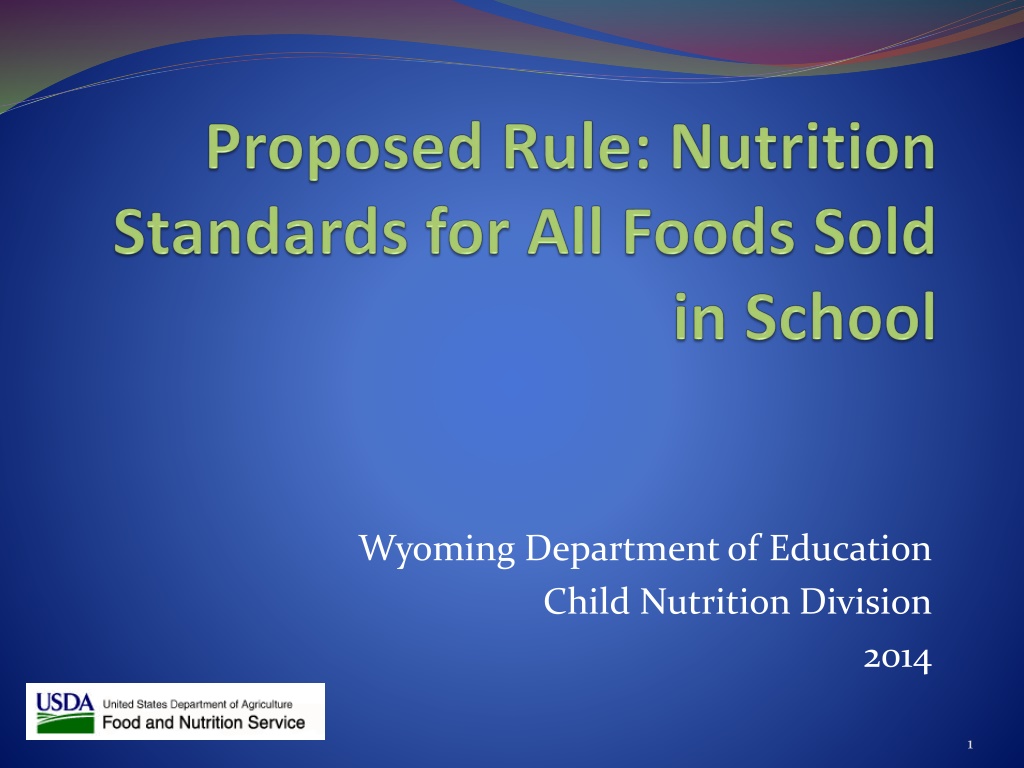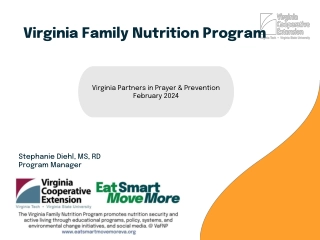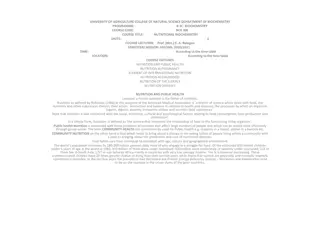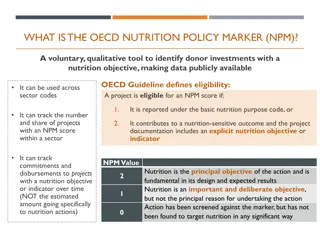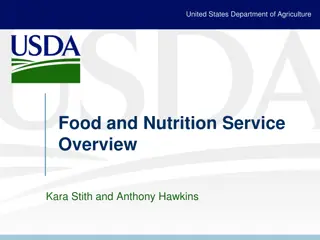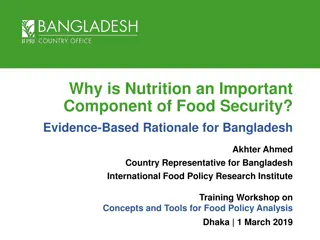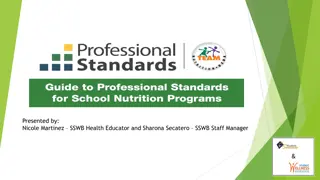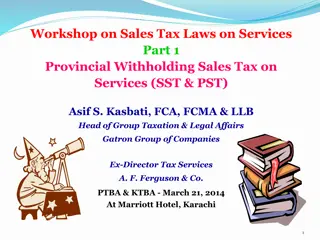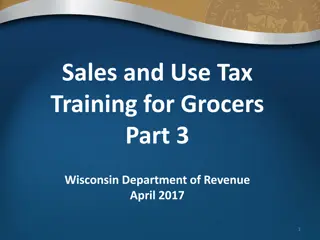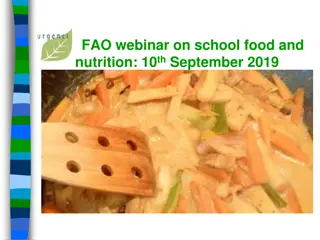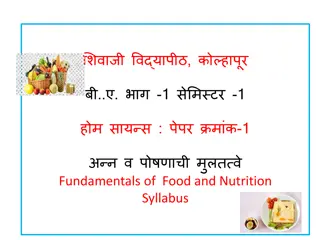Nutrition Standards for School Food Sales
Proposed rules outline nutrition standards for all foods sold in schools to improve children's diets and health. The background emphasizes the importance of school nutrition programs, while the Healthy, Hunger-Free Kids Act grants authority to establish these standards. The proposal development considered various recommendations and input to enhance the nutritional profile of foods available to students.
Download Presentation

Please find below an Image/Link to download the presentation.
The content on the website is provided AS IS for your information and personal use only. It may not be sold, licensed, or shared on other websites without obtaining consent from the author. Download presentation by click this link. If you encounter any issues during the download, it is possible that the publisher has removed the file from their server.
E N D
Presentation Transcript
Wyoming Department of Education Child Nutrition Division 2014 1
Proposed Rule Title: Nutrition Standards for All Foods Sold in School Published: Feb. 8, 2013 2
Presentation Outline Requirements for All Foods Standards Recordkeeping 3
Background A significant portion of calories consumed by children are consumed at school. Federal child nutrition programs are an important source of nutritious, balanced meals. Despite progress in meal quality, work remains to improve children's diets. Research has consistently shown that American children do not meet current national dietary recommendations. 4
Background Improving the nutritional profile of all foods sold in school is critical to: improve diet and overall health of American children ensure children from all income levels adopt healthful eating habits that will enable them to live productive lives. 5
Proposal Development USDA considered a wide range of information available on competitive foods, including: Recommendations of the 2007 Institute of Medicine (IOM) Report; USDA s HUSSC standards; Existing State and local standards; Existing voluntary standards and recommendations; and Input from nutrition program stakeholders. 6
Further Considerations The practical application of standards in school settings; Context of new meal patterns for the Federal school meal programs; Support of the federally- reimbursed school nutrition programs as the major source of foods and beverages offered at school; 7
Healthy, Hunger-Free Kids Act USDA has new authority to establish nutrition standards for all foods and beverages sold outside of the Federal child nutrition programs in schools. The provisions specify that the nutrition standards shall apply to all foods sold: outside the school meal programs; on the school campus; and at any time during the school day. Section 208, HHFKA 8
Healthy, Hunger-Free Kids Act Requires standards be consistent with most recent Dietary Guidelines for Americans Directs the Secretary to consider: authoritative scientific recommendations, existing school nutrition standards, current State and local standards, practical application of standards and exemptions for school-sponsored fundraisers. 9
Impact on students The proposed changes are intended to: improve the health of the Nation s children, increase consumption of healthful foods during the school day and create an environment that reinforces the development of healthy eating habits. 10
Minimum Standards The nutrition standards for all foods sold in school are minimum standards. Additional State or local standards are allowed if consistent with the final rule. 11
Definitions Nutrition standards for competitive foods apply to all foods and beverages sold: outside the school meals programs; on the school campus; and at any time during the school day. 13
Proposed Definitions Competitive food: all food and beverages sold to students on the School campus during the School day, other than those meals reimbursable under programs authorized by the NSLA and the CNA. 14
Proposed Definitions School campus: all areas of the property under the jurisdiction of the school that are accessible to students during the school day. 15
Proposed Definitions School day: the period from the midnight before, to 30 minutes after the end of the official school day. 16
What Areas Will the Rule Affect? Foods sold a la carte with in food service School Stores Vending Machines Food-based fundraisers that take place during the school day Snack Bars 18
Entre (a la Carte) Foods Nutrition Facts Calories < 350 % Daily Value Total Fat < 35% o Sat Fat < 10 % o Trans Fat 0 (< 0.5 g per serving) Sodium < 480 mg Sugar < 35% [grams of sugar divided by total weight of serving in grams] times 100 = % 19
Smart Entre (a la Carte) Foods Tomato-Mozzarella Pizza with whole grain crust Salsa Chicken Pineapple Salsa Chicken Pulled BBQ Chicken Pulled BBQ Pork Veggie burger Turkey and Veggie Melt 20
Smart Snack/Side Nutrition Facts Calories < 200 % Daily Value Total Fat < 35% o Sat Fat < 10 % o Trans Fat 0(< 0.5 g per serving) Sodium < 230 mg (including accompaniments) Sugar < 35% [grams of sugar divided by total weight of serving in grams] times 100 = % 21
Ideas for Brain-Boosting Snacks: Choose Whole Grain: Baked Chips and Tortilla Chips Baked Crackers Granola Bars and Cereal Bars Sandwiches Wraps Bagels Popcorn Dried Fruit Raisins, mango, bananas Fruit Cups (fresh or canned) berries, applesauce, peach Fresh Fruit apple, pear, banana, kiwi, peach, ChooseMyPlate.gov Fresh Vegetables with Dip hummus, low fat dressing, peanut butter Raw Vegetables celery, carrots, broccoli, cherry tomatoes, snap peas, cucumber, peppers Grab and Go Salad Beef Jerky Peanut Butter Hard Boiled Eggs Nuts and Seeds Trail Mix Yogurt String cheese Milk 22
Brain-Boosting Beverages Elementary Middle High Flavored and/or Carbonated Beverages < 40 Calories per 8 fl oz NO NO < 8 fl oz < 60 Calories per 12 fl oz NO NO < 12 fl oz < 5 Calories per 8 fl oz < 10 Calories per fl oz NO NO < 20 fl oz Beverages with Caffeine No No YES Unless naturally occurring trace amounts Unless naturally occurring trace amounts High school beverages may contain caffeine Plain water or plain Carbonated Water No size limit No size limit No size limit 23
Brain-Boosting Beverages: Elementary Middle High Milk Low fat (1%) Unflavored < 8 fl oz < 12 fl oz < 12 fl oz Skim Flavored or Unflavored < 8 fl oz < 12 fl oz < 12 fl oz Nutritionally Equivalent < 8 fl oz < 12 fl oz < 12 fl oz Fruit and/or Vegetable Juice 100% Juice < 8 fl oz < 12 fl oz < 12 fl oz 100% juice diluted with water and no added sweeteners (with or without carbonation) < 8 fl oz < 12 fl oz < 12 fl oz 24
Smart Beverage Ideas Low fat (1%) White Milk Fat-free (skim) White Milk Fat-free (skim) Flavored Milk 100% Juice Sparkling 100 % Juice Water Sparkling Water 25
What Areas Will the Rule Not Affect? Concessions after school, off campus, or on weekends Food & snacks students bring from home Classroom events (holiday parties) Teachers lounges 26
Fundraisers Exemption The HHFKA allows each State Agency the discretion to exempt from 0-5 school-sponsored fundraisers. The Wyoming SA has determined that 5 school- sponsored fundraisers will be allowed at each school The fundraiser length of each will be no longer than 2 weeks in length. The exempt fundraisers will be prohibited during the school meal service. 27
Recordkeeping Records must be maintained by those designated as responsible for any competitive food service in the school. 29
State Agency Monitoring State agencies will monitor compliance with the standards through a review of local educational agency records as part of the State agency administrative review. If violations have occurred, corrective action plans would be required to be submitted to the State agency. 30
Questions? 31
